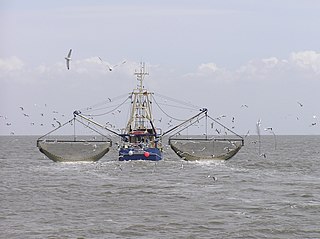Marine systems
Ecosystem-based management of marine environments has begun to move away from the traditional strategies which focus on conservation of single species or single sectors in favor of an integrated approach which considers all key activities, particularly anthropogenic, that affect marine environments. [14] [15] Management must take into account the life history of the fish being studied, its association with the surrounding environment, its place in the food web, where it prefers to reside in the water column, and how it is affected by human pressures. The objective is to ensure sustainable ecosystems, thus protecting the resources and services they provide for future generations. [16]
In recent years there has been increasing recognition of anthropogenic disruption to marine ecosystems resulting from climate change, overfishing, nutrient and chemical pollution from land runoff, coastal development, bycatch, and habitat destruction. The effect of human activity on marine ecosystems has become an important issue because many of the benefits provided to humans by marine ecosystems are declining. These services include the provision of food, fuel, mineral resources, pharmaceuticals, as well as opportunities for recreation, trade, research and education. [17]
Guerry (2005) has identified an urgent need to improve the management of these declining ecosystems, particularly in coastal areas, to ensure sustainability. Human communities depend on marine ecosystems for important resources, but without holistic management, these ecosystems are likely to collapse. Olsson et al. (2008) suggest that the degradation of marine ecosystems is largely the result of poor governance and that new approaches to management are required. [18] The Pew Oceans Commission and the United States Commission on Ocean Policy have indicated the importance of moving from current piecemeal management to a more integrated ecosystem-based approach. [19] [20]
Stock assessment

Stock assessment is a critically important aspect of fisheries management, but it is a highly complex, logistically difficult, and expensive process and can thus be a contentious issue, particularly when competing parties disagree on the findings of an assessment. [21] Accurate stock assessments require knowledge of reproductive and morphological patterns, age-at-stage progressions, and movement ecology. [22]
Bottom up or top down

All members of an ecosystem are affected by other organisms within that ecosystem, and proper management of wildlife requires knowledge of an organism's trophic level and its effects on other organisms within its food web. Top-down and bottom-up controls represent one method by which the numbers of wild populations of plants and animals are limited. Top-down controls have been seen in the explosion of sea urchins and subsequent decline in kelp beds due to the near-extirpation of sea otters.As otters were hunted nearly to extinction, sea urchins - preyed on by sea otters and which themselves feed on the kelp - boomed, resulting in the near-disappearance of kelp beds. [23] Bottom-up controls are best illustrated when autotrophic primary producers such as plants and phytoplankton, which represent the lowest trophic level of an ecosystem, are limited, impacting all organisms in higher trophic levels, but bottom-up changes can also be seen in higher trophic levels. For example, the decline of North Sea puffins has been attributed to overexploitation of sand eels, an important prey item. [24]
Bycatch
Red snapper is a species of enormous economic importance in the Gulf of Mexico. Management of this species is complicated by the large impact of bycatch associated with the shrimping industry. [25] Rates of red snapper mortality are not explained by fishery landings, but are instead associated with large numbers of juvenile red snapper caught as bycatch in the fine mesh used by trawlers. [26]
Key elements
Connections
At its core, ecosystem-based management is about acknowledging interdependency connections, including the linkages between marine ecosystems and human societies, economies and institutional systems, as well as those among various species within an ecosystem and among ocean places that are linked by the movement of species, materials, and ocean currents. [27] Of particular importance is how these factors all react and involve each other. In the Caribbean, the spiny lobster is managed based on a classic population model that for most fishery species works quite well. [28] However, this species will grow and then halt its growth when it need to molt its shell and thus instead of a continuous growth cycle, it will pause its growth and invest its energy in a new shell. [29] To further complicate matters, it slows this process down as it gets older to invest more energy into reproduction thus further deviating itself from the von Bertalanffy model of growth that was applied to it. [30] The more information we can gather about an ecosystem and all of the interconnected factors which affect it, the more capable we will be of better managing that system.
Cumulative impacts
Ecosystem-based management focuses on how individual actions affect the ecosystem services that flow from coupled socio-ecological systems in an integrated fashion, rather than considering these impacts in a piecemeal manner. [31] Loss of biodiversity in marine ecosystems is an example of how cumulative effects from different sectors can impact on an ecosystem in a compounding way. Overfishing, coastal development, filling and dredging, mining and other human activities all contribute to the loss of biodiversity and therefore degradation of the ecosystem. [32] Work is needed prior to the carrying out of the research to understand the total effects that each species can have on each other and also on the environment. It must be carried out every year as well as species are changing their life history traits and their relationship with the environment as humans are continually modifying the environment.
Interactions between sectors
The only way to deal with the cumulative effects of human influences on marine ecosystems is for various contributing sectors to set common goals for the protection or management of ecosystems. While some policies may only affect a single sector, others may affect multiple sectors. A policy for the protection of endangered marine species, for example, could affect recreational and commercial fisheries, mining, shipping and tourism sectors to name a few. More effective ecosystem management would result from the collective adoption of policies by all sectors, rather than each sector creating their own isolated policies. For example, in the Gulf of Mexico there are oil rigs, recreational fisheries, commercial fisheries and multiple tourist attractions. One of the main fisheries is that of the Red Snapper which inhabits much of the Gulf and employs thousands of people in the commercial and recreational fishery. During the Deepwater oil spill it became abundantly obvious that it negatively affected the population numbers as well as the integrity of the catch that was being made. The species not only suffered higher mortality rates but the market was less trusting of the product. An environmental disaster interacted with the commercial, recreational, and economic sector for a specific species.
Changing public perceptions
Not all members of the public will be properly informed, or be fully aware, of current threats to marine ecosystems and it is therefore important to change public perceptions by informing people about these issues. It is important to consider the interest of the public when making decisions about ocean management and not just those who have a material interest because community support is needed by management agencies in order to make decisions. The Great Barrier Reef Marine Park Authority (GBRMPA) faced the issue of poor public awareness in their proposed management strategy which included no-take fishing zones. Olssen (2008) addressed this problem by starting a 'reef under pressure' information campaign to prove to the public that the Great Barrier Reef is under threat from human disturbances, and in doing so were successful in gaining public support.
Bridging science and policy
To ensure that all key players are on the same page, it is important to have communication between managers, resource users, scientists, government bodies and other stakeholders. Leslie and McLeod (2007) stated that proper engagement between these groups will enable the development of management initiatives that are realistic and enforceable as well as effective for ecosystem management. If certain small-scale players are not involved or informed, it is highly unlikely and equally challenging to get them to cooperate as well as to follow the rules that need to be put in place. It is of the utmost importance to have every stakeholder involved with every step of the process to increase the cohesion of the process.
Embracing change
Coupled social-ecological systems are constantly changing in ways that cannot be fully predicted or controlled. Understanding the resilience of ecosystems, i.e. the extent to which they can maintain structure, function, and identity in the face of disturbance, can enable better prediction of how ecosystems will respond to both natural and anthropogenic perturbations, and to changes in environmental management. With how much modification humans are doing to environments, it is important to understand these changes on a yearly basis as well. Some species are changing their life histories, Flounder, due to the increased pressures that humans are placing on the environment. Thus, when a manager or government does an assessment on the ecosystem for a given year, the relationship that a species has to others can change very quickly and thus negate the model that you use for an ecosystem very quickly if not redefined.
Multiple objectives
Ecosystem-based management focuses on the diverse benefits provided by marine systems, rather than on single ecosystem services. Such benefits or services include vibrant commercial and recreational fisheries, biodiversity conservation, renewable energy from wind or waves and coastal protection. The goal is to provide a sustainable fisheries while incorporating the impacts of other aspects on that resource. When managed correctly, an ecosystem-based model can greatly improve not only the resource being managed, but those associated with it.
Learning and adaptation
Because of the lack of control and predictability of coupled social-ecological systems, an adaptive management approach is recommended. There can be multiple different factors that must be overcome (fisheries, pollution, borders, multiple agencies, etc.) to create a positive outcome. Managers must be able to react and adapt as to limit the variance associated with the outcome.















